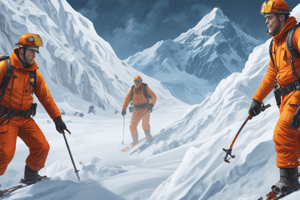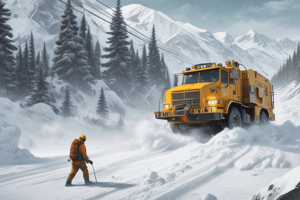Podcast
Questions and Answers
What is the primary cause of fatal avalanches?
What is the primary cause of fatal avalanches?
- Movement of loose, dry, fresh snow
- Accumulation of storm snow
- Strong solar radiation
- Victim or their party activities (correct)
Which type of avalanche is characterized by a dense layer of snow sliding on a weaker layer?
Which type of avalanche is characterized by a dense layer of snow sliding on a weaker layer?
- Cornice collapse
- Loose snow avalanche
- Slab avalanche (correct)
- Icefall avalanche
What effect does surface hoar have on the snowpack?
What effect does surface hoar have on the snowpack?
- Creates a solid bond in the snowpack
- Acts as a protective crust
- Increases avalanche stability
- Forms a weak layer once buried (correct)
What initiates a loose snow avalanche?
What initiates a loose snow avalanche?
Which factor is NOT a primary trigger for natural avalanches?
Which factor is NOT a primary trigger for natural avalanches?
What is a cornice in the context of avalanche formation?
What is a cornice in the context of avalanche formation?
What type of avalanche starts from a point and spreads out like a teardrop?
What type of avalanche starts from a point and spreads out like a teardrop?
Which type of weak layer can last for months at the base of shallow snow packs?
Which type of weak layer can last for months at the base of shallow snow packs?
What happens to the weak layer in a slab avalanche when overlaid by a stronger layer?
What happens to the weak layer in a slab avalanche when overlaid by a stronger layer?
Which weather condition is NOT a common factor in avalanche formation?
Which weather condition is NOT a common factor in avalanche formation?
What is a sign that a wet slab may be present?
What is a sign that a wet slab may be present?
What is the primary danger associated with deep persistent slabs?
What is the primary danger associated with deep persistent slabs?
Which condition increases the risk of loose wet avalanches?
Which condition increases the risk of loose wet avalanches?
When performing a signal search in avalanche rescue, what is the first step?
When performing a signal search in avalanche rescue, what is the first step?
What should NOT be done when trying to spot a cornice?
What should NOT be done when trying to spot a cornice?
What is the ideal team size for an avalanche rescue operation?
What is the ideal team size for an avalanche rescue operation?
What indicates that snow is likely in a dangerous unstable state?
What indicates that snow is likely in a dangerous unstable state?
What should a companion do while another performs a fine search?
What should a companion do while another performs a fine search?
In which cases should you call for help during a rescue effort?
In which cases should you call for help during a rescue effort?
What is the correct method for probing during an avalanche rescue?
What is the correct method for probing during an avalanche rescue?
What is the primary purpose of using explosives in avalanche control?
What is the primary purpose of using explosives in avalanche control?
What class of avalanche is classified as having the potential to bury and injure a person?
What class of avalanche is classified as having the potential to bury and injure a person?
What angle range is considered most common for avalanche-prone slopes?
What angle range is considered most common for avalanche-prone slopes?
What does the term 'runout zone' refer to in avalanche terminology?
What does the term 'runout zone' refer to in avalanche terminology?
What impact do terrain traps generally have in an avalanche situation?
What impact do terrain traps generally have in an avalanche situation?
How does wind exposure affect snow on slopes?
How does wind exposure affect snow on slopes?
What is the primary rating system used for evaluating the exposure of backcountry terrain to avalanches?
What is the primary rating system used for evaluating the exposure of backcountry terrain to avalanches?
Which attribute is commonly measured to classify slopes in avalanche forecasting?
Which attribute is commonly measured to classify slopes in avalanche forecasting?
What avalanche danger rating indicates a high likelihood of large avalanches occurring?
What avalanche danger rating indicates a high likelihood of large avalanches occurring?
In avalanche terms, how is 'cross loading' defined?
In avalanche terms, how is 'cross loading' defined?
What is an important feature of simple terrain in the ATES classification?
What is an important feature of simple terrain in the ATES classification?
Why can slopes facing the sun lead to avalanche formation?
Why can slopes facing the sun lead to avalanche formation?
What is the significance of having no ATES rating for a backcountry area?
What is the significance of having no ATES rating for a backcountry area?
Flashcards
Avalanche Types
Avalanche Types
Different types of avalanches are categorized by how the snow moves and the structure of the snowpack.
Slab Avalanche
Slab Avalanche
A slab of strong snow sliding over a weaker layer of snow.
Loose Snow Avalanche
Loose Snow Avalanche
Loose snow sliding down a slope due to poor bonding between snow crystals.
Cornice
Cornice
Signup and view all the flashcards
Avalanche Triggering
Avalanche Triggering
Signup and view all the flashcards
Weak Layer
Weak Layer
Signup and view all the flashcards
Snowpack
Snowpack
Signup and view all the flashcards
Avalanche Conditions
Avalanche Conditions
Signup and view all the flashcards
Fatal Avalanches
Fatal Avalanches
Signup and view all the flashcards
Avalanche Terrain
Avalanche Terrain
Signup and view all the flashcards
Persistent Slab
Persistent Slab
Signup and view all the flashcards
Deep Persistent Slab
Deep Persistent Slab
Signup and view all the flashcards
Wet Slab
Wet Slab
Signup and view all the flashcards
Loose Wet Avalanche
Loose Wet Avalanche
Signup and view all the flashcards
Loose Dry Avalanche (Sluff)
Loose Dry Avalanche (Sluff)
Signup and view all the flashcards
Avalanche Forecast - Danger Rating
Avalanche Forecast - Danger Rating
Signup and view all the flashcards
Trip Planning - Avalanche Risk
Trip Planning - Avalanche Risk
Signup and view all the flashcards
Signs of Avalanche Instability
Signs of Avalanche Instability
Signup and view all the flashcards
Slope Evaluation
Slope Evaluation
Signup and view all the flashcards
Artificial Triggers
Artificial Triggers
Signup and view all the flashcards
Avalanche Size Classification
Avalanche Size Classification
Signup and view all the flashcards
Avalanche Path
Avalanche Path
Signup and view all the flashcards
Start Zone
Start Zone
Signup and view all the flashcards
Runout Zone
Runout Zone
Signup and view all the flashcards
Slope Angle
Slope Angle
Signup and view all the flashcards
Slope Size and Shape
Slope Size and Shape
Signup and view all the flashcards
Terrain Traps
Terrain Traps
Signup and view all the flashcards
Slope Aspect
Slope Aspect
Signup and view all the flashcards
Wind Slabs
Wind Slabs
Signup and view all the flashcards
Avalanche Terrain Exposure Scale (ATES)
Avalanche Terrain Exposure Scale (ATES)
Signup and view all the flashcards
Avalanche Forecast
Avalanche Forecast
Signup and view all the flashcards
Avalanche Danger Rating
Avalanche Danger Rating
Signup and view all the flashcards
Storm Slabs
Storm Slabs
Signup and view all the flashcards
Study Notes
Avalanche Safety - Study Notes
- Avalanche Causation: Over 90% of fatal avalanches are caused by the victim or their group.
Avalanche Types
-
Slab Avalanche: A dense layer of snow breaks off and slides on a weaker layer within the snowpack. This is highly dangerous, reaching speeds over 130 km/hr. Weak layers can stem from temp fluctuations or are created by storms. Slab avalanches are cohesive at first but break into chunks.
-
Loose Snow Avalanche (or Sluff): A poorly bonded surface layer of snow slides downhill under its own weight. It has a less dangerous nature than slab avalanches, starting at one point and spreading like a tear shape.
-
Cornices: Wind-deposited snow masses protruding from ridges/peaks. They can break off and trigger larger avalanches (or be a trigger for slab avalanches) due to stress from gravity, weather changes, or weight (human or machine).
Avalanche Formation
-
Weather's Role: Weather is the primary driver of avalanche formation, creating different snowpack layers with varying strengths and weaknesses. Snow crystals bond differently depending on weather conditions over time, thus creating strong and weak layers.
-
Weak Layers: Storm snow, surface hoar (frozen dew that creates feathery crystals), facets (different temp in snowpack, sharp sides of grains, no cohesion b/w snow crystals), depth hoar (persistent, large cup shaped layer), and crusts (melted then refrozen snow- often used as a sliding surface) are all problematic weak layers in snowpacks.
Avalanche Triggers
-
Natural Triggers: New snow loading, windblown snow, rain, rapid temp increase, and strong solar radiation all initiate natural avalanches.
-
Human Triggers: People and machines trigger many avalanches, and the triggering effect can be from many meters away!
-
Artificial Triggers: Explosives are used (deliberately) to release avalanches in ski areas or highway passes, to keep the size manageable.
Avalanche Sizes
- Classification: Avalanches are rated from 1 (smallest) to 5 (largest) based on their destructive potential. Size 1 avalanches are relatively harmless to people but still pose risks. Sizes 2–5 can bury, injure, or kill people/destroy property.
Avalanche Terrain
-
Terrain Characteristics: Avalanche paths (start zone, track, runout zone; sometimes delineated by trim lines) are critical areas. Slope angle is vital; 30-45 degrees is most common for slab avalanches. Steeper slopes (over 45 degrees) have fewer slab avalanches.
-
Slope Shape: Convex slopes (steepest point near the top) are more prone to fractures.
-
Terrain Traps: Terrain features like rocks, trees, and cliffs increase avalanche severity, as do sudden flat spots, which can lead to deeper burials.
-
Slope Aspect and Wind: Slopes facing winds(windward), have wind slabs formed because they carry the snow to the leeward side of slopes. Solar radiation impacts sun-facing slopes with potential to form hard crusts and weakens the slope.
Avalanche Exposure Scale
- ATES: A system for rating backcountry terrain's avalanche exposure into Simple (green), Challenging (blue), and Complex (black) categories. Using 11 different weighted measures!
Avalanche Forecast
-
Importance: The forecast is a key component of planning any backcountry trip, providing danger ratings (1-5), problems (types of avalanches and terrain), and details (local conditions, weather).
-
Danger Ratings: Based on the North American public avalanche danger scale, which provides the likelihood of avalanches and their size.
-
Avalanche Problems: Storm slab, wind slab (look for stiffness under feet, hollow noises), persistent slabs, wet slabs (rain, temp increase), cornices, loose wet, and loose dry (sluffs) are all discussed in detail to help assess danger.
Daily Process
-
Group Formation: Create small and efficient groups (3–5 people).
-
Trip Planning: Assess the forecast and create a plan, including plan B.
-
Gear Check: Check and verify all necessary gear (batteries).
-
Condition Verification: Check weather/snow conditions, assess safety, etc
-
Communication and Travel Habits: Maintain communication, have a clear escape plan, and look for signs of instability like drifting/cracking/recent avalanches.
Companion Rescue
-
Quick Action: Immediate actions are crucial.
-
Leader Selection: Designate a leader.
-
Scene Assessment: Assess safety, overhead hazards.
-
Headcount and Search: Figure out where last seen.
-
Transceiver Search: Signal, coarse, and fine search phases are explained. The transceiver shows distance and direction.
-
Probing and Shoveling: Systematic techniques are given.
-
When to Call for Help: Only if necessary, and don't take up too much rescue time.
Studying That Suits You
Use AI to generate personalized quizzes and flashcards to suit your learning preferences.




